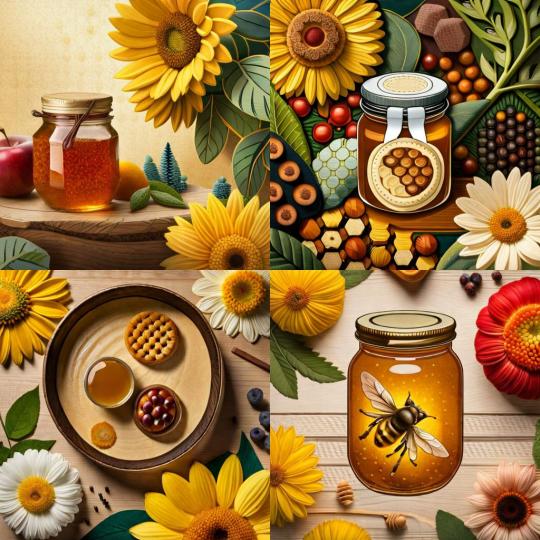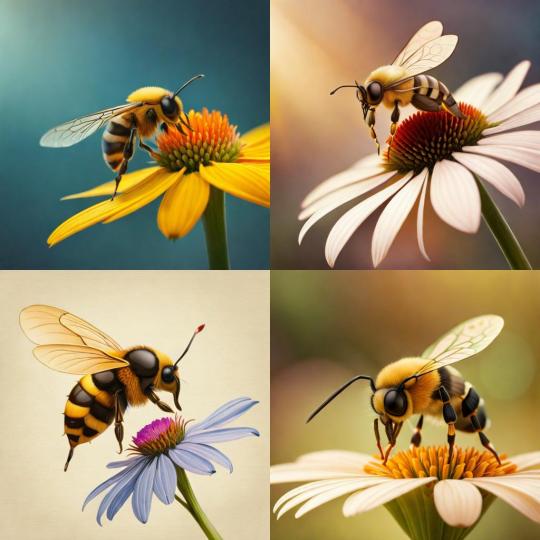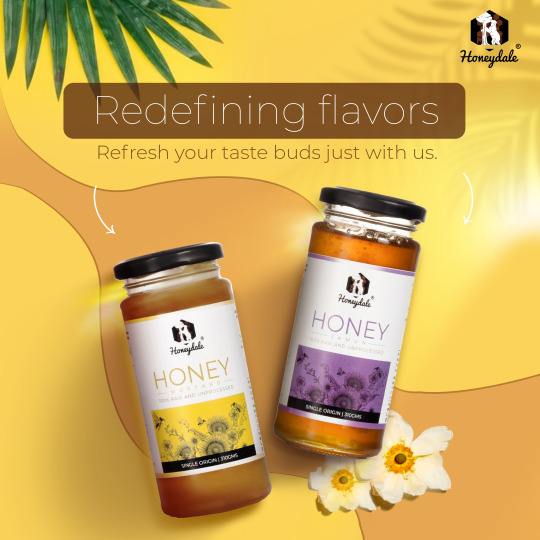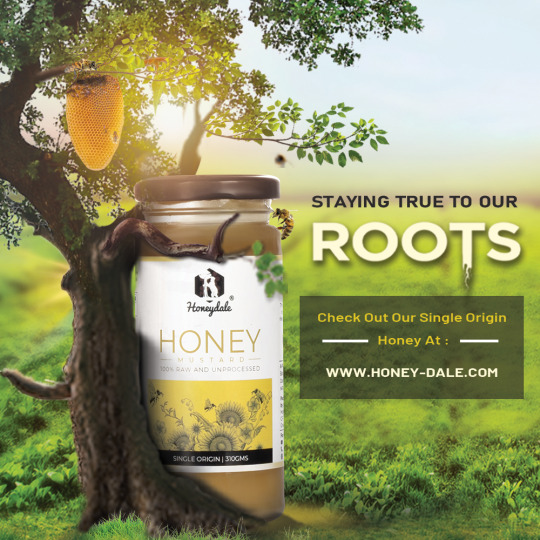Text
Exploring the World of Artisanal Honey: From Local
Exploring the World of Artisanal Honey: From Local
I. Introduction
A. Overview of the growing interest in artisanal honey:
In recent years, there has been a remarkable surge in consumer interest and demand for high-quality, artisanal honey. People are becoming more conscious of the origin and production methods of their food, seeking out unique and authentic products. Artisanal honey has emerged as a popular choice for those who value natural, flavorful, and sustainably produced food items. This article aims to explore the world of artisanal honey, with a particular focus on local varieties and their diverse characteristics.
B. Importance of exploring local varieties of honey:
Exploring local honey varieties is not only a gustatory adventure but also a way to connect with the rich heritage and traditions of a region. Each geographic area boasts unique floral sources, resulting in honey with distinct flavors and qualities. By delving into local honey, consumers can appreciate the terroir of different regions, savoring the delicate nuances that make each honey special. Additionally, supporting local beekeepers and their communities helps preserve traditional beekeeping practices and maintain a healthy ecosystem.
II. Understanding Artisanal Honey
A. Definition and characteristics of artisanal honey:
Artisanal honey refers to honey that is produced on a smaller scale, with a focus on craftsmanship, quality, and attention to detail. Unlike mass-produced commercial honey, which often undergoes industrial processing and blending, artisanal honey is typically harvested from specific floral sources and with minimal intervention. It is characterized by its purity, distinct flavors, and the absence of additives or heat treatment that can alter its natural qualities.
B. Differentiation from commercial honey:
Commercial honey is often produced in large quantities, sourced from various locations and blended to create a consistent product. In contrast, artisanal honey is more akin to a single-origin specialty, showcasing the unique attributes of a particular floral source or region. It embodies the dedication and passion of beekeepers who prioritize quality over quantity, employing sustainable beekeeping practices and preserving the integrity of the honey.
III. Exploring Local Varieties
A. Highlighting the diversity of honey based on floral sources and geographical regions:
The world of honey is incredibly diverse, with flavors, colors, and aromas varying depending on the nectar collected by bees from different flowers. Each floral source imparts distinct characteristics to the honey, resulting in a wide array of taste profiles. From the delicate floral notes of lavender honey to the mild and sweet nuances of acacia honey, exploring local varieties opens up a world of flavors waiting to be discovered.
B. Prominent local varieties and their unique flavor profiles:
Local honey varieties are often celebrated for their exceptional flavors. For instance, lavender honey, derived from the nectar of lavender blossoms, offers a delicate floral aroma with a hint of herbal undertones. On the other hand, tupelo honey, sourced from the blossoms of the tupelo tree, boasts a smooth, buttery taste with a subtle fruity finish. These unique flavor profiles are a result of the specific floral sources and environmental conditions in which the bees forage, making each local honey variety a distinctive culinary experience.
IV. The Role of Beekeepers
A. Importance of beekeepers in producing artisanal honey:
Beekeepers play a crucial role in the production of artisanal honey. They are responsible for maintaining healthy bee colonies, ensuring optimal conditions for honey production, and promoting the well-being of the bees. Their expertise and dedication contribute to the overall quality of artisanal honey, as they implement sustainable beekeeping practices that prioritize the health of the bees and the preservation of the ecosystem.
B. Their commitment to sustainable and ethical practices:
Artisanal beekeepers are committed to sustainable and ethical beekeeping practices. They strive to create a harmonious balance between honey production and environmental conservation. This includes providing natural habitats for bees, minimizing the use of pesticides, and promoting biodiversity by cultivating a diverse range of flowering plants. By supporting artisanal beekeepers, consumers contribute to the preservation of pollinators and the health of our ecosystems.
V. The Journey from Hive to Jar
A. Overview of the honey production process:
Honey production is a fascinating journey that begins with bees collecting nectar from flowers. The bees then transform the nectar into honey through a process of enzymatic reactions and evaporation. Once the honey is ripened and stored in honeycombs, beekeepers carefully extract it, ensuring minimal disruption to its natural properties. The honey is then strained or filtered to remove impurities, packaged, and made available for consumers to enjoy.
B. Emphasizing the care and attention to detail involved in artisanal honey production:
Artisanal beekeepers pay meticulous attention to every stage of honey production. They monitor hive health, conduct regular inspections, and ensure that bees have access to a variety of flowering plants to gather nectar from. The extraction process is gentle, often involving techniques like cold extraction or centrifugal force to preserve the honey's natural enzymes, aromas, and flavors. Each jar of artisanal honey represents the passion and dedication of the beekeeper and the bees that produced it.
VI. Tasting Notes and Pairings
A. Describing the sensory experience of tasting artisanal honey:
Tasting artisanal honey is a multisensory experience that engages the palate, aroma, and visual perception. When sampling honey, one can observe its color, ranging from pale gold to dark amber, and appreciate its viscosity and texture. As the honey coats the tongue, its flavors unfold, revealing a myriad of taste notes. Delicate floral hints, fruity undertones, or even earthy and spicy nuances can be discovered, depending on the floral source and the region the honey originates from.
B. Suggesting food and beverage pairings to enhance the flavors:
Artisanal honey can be paired with various foods and beverages to create delightful taste combinations. For example, a light and floral honey like orange blossom honey pairs well with fresh fruits, while a robust and rich honey like buckwheat honey complements strong cheeses or drizzled over warm desserts. Honey can also be used as a natural sweetener in beverages, enhancing the flavors of tea, coffee, or cocktails. The possibilities for culinary exploration and experimentation are endless.
VII. Supporting Local Communities
A. Economic and social impact of artisanal honey production:
Artisanal honey production has a positive economic and social impact on local communities. By supporting local beekeepers, consumers contribute to the livelihoods of these individuals and their families. The success of artisanal beekeepers often stimulates economic growth in rural areas, fostering vibrant communities and preserving traditional beekeeping practices.
B. Importance of supporting local beekeepers and their communities:
Supporting local beekeepers is not only about enjoying high-quality honey but also about safeguarding the environment and promoting sustainable practices. Local beekeepers play a crucial role in pollination, which is essential for the growth of crops and the maintenance of biodiversity. By purchasing honey directly from local beekeepers or through farmers' markets, consumers actively participate in the preservation of bees, their habitats, and the delicate balance of nature.
VIII. The Art of Honey Appreciation
A. Exploring honey tasting events and workshops:
Honey tasting events, workshops, or honey-themed festivals have gained popularity as opportunities for enthusiasts to explore the nuances of different honey varieties. These events often involve guided tastings, where participants learn about honey production, hone their tasting skills, and discover the subtleties of flavor profiles. They offer a chance to engage with experts, beekeepers, and fellow honey enthusiasts, fostering a community that appreciates the art of honey.
B. Tips for individuals interested in developing their palate for honey:
For those interested in expanding their honey palate, conducting a honey tasting at home can be a rewarding experience. Start with a selection of different local honey varieties, preferably sourced directly from beekeepers. Observe the color, aroma, and consistency of each honey and take small sips to savor the complex flavors. Experiment with pairing honey with various foods to discover new taste combinations. Additionally, resources such as books, online courses, or guided tastings can provide further guidance and knowledge for honey enthusiasts.
IX. Sustainability and Conservation Efforts
A. Highlighting the importance of bee conservation:
Bees play a vital role in pollinating a wide range of plants, including many crops that humans rely on for food production. However, bees face numerous threats, such as habitat loss, pesticide exposure, and climate change, leading to a decline in bee populations. Emphasizing the importance of bee conservation raises awareness about the ecological significance of these pollinators and the urgent need to protect their populations.
B. Showcasing initiatives and organizations working towards honeybee preservation:
Numerous initiatives and organizations are dedicated to preserving bees and their habitats. They focus on research, advocacy, and public education to raise awareness about the importance of bees and the role of sustainable beekeeping practices. By supporting these initiatives, consumers contribute to the preservation of bees, biodiversity, and the long-term health of our ecosystems.
Summary
A. Recap of the significance of exploring artisanal honey:
Exploring the world of artisanal honey, particularly local varieties, offers a delightful culinary journey that celebrates the diversity of flavors and supports sustainable beekeeping practices. It allows individuals to connect with the heritage of a region, taste the unique characteristics of different floral sources, and contribute to the preservation of local communities and ecosystems.
B. Encouragement to support local beekeepers and experience the world of honey firsthand:
In conclusion, this article encourages readers to seek out and experience the diverse flavors of artisanal honey produced by local beekeepers. By supporting these beekeepers, consumers not only gain access to exceptional honey but also contribute to the well-being of bees, the environment, and the preservation of centuries-old beekeeping traditions. Through mindful choices and appreciation for the world of honey, individuals can make a positive impact on both their palates and the planet.
Experience the Artisanal Delights of Honey Dale
Honey Dale:
Honey Dale is a renowned artisanal honey brand that specializes in producing high-quality, locally sourced honey. Their commitment to sustainable beekeeping practices and dedication to preserving the unique flavors of different floral sources make them a trusted choice for honey enthusiasts.
B. Encouragement to support Honey Dale:
By supporting Honey Dale, you not only gain access to exceptional honey but also contribute to the preservation of local beekeeping traditions and the well-being of bees. Here's how you can get involved:
1. Purchase Honey Dale's artisanal honey:
Visit their website or local retailers to explore their range of honey varieties. From the delicate sweetness of wildflower honey to the robust flavors of forest honey, each jar represents the craftsmanship and passion of Honey Dale's beekeepers.
2. Share your Honey Dale experience:
If you've had the pleasure of savoring Honey Dale's honey, share your experience with others. Leave reviews on their website or social media platforms to help spread the word about the exceptional flavors and commitment to sustainability.
3. Attend Honey Dale's events and workshops:
Stay updated on Honey Dale's upcoming events, honey tasting sessions, and workshops. Participating in these activities will deepen your appreciation for artisanal honey, expand your knowledge, and connect you with fellow honey enthusiasts.
4. Support honeybee conservation efforts:
Be an advocate for honeybee conservation by learning more about the challenges they face and supporting organizations dedicated to protecting bees and their habitats. By raising awareness and taking action, you contribute to the long-term health of bees and the ecosystems they support.
C. Embrace the world of Honey Dale:
Start your journey of honey exploration with Honey Dale. Experience the artistry, flavors, and benefits of their artisanal honey while supporting sustainable beekeeping practices. Join the Honey Dale community today and discover the richness that nature's golden elixir has to offer.
0 notes
Text
Honey and Athletic Performance: Fueling Workouts and Recovery
Honey has long been celebrated for its natural sweetness and health benefits, but its potential impact on athletic performance is often overlooked. This article aims to shed light on the role of honey in fueling workouts and aiding in post-workout recovery for athletes. By exploring its benefits as a natural energy source, its impact on endurance and stamina, its role in muscle recovery, and its advantages as a natural alternative to sports nutrition products, athletes can discover the potential of honey in optimizing their performance and recovery.
I. The Role of Nutrition in Athletic Performance:
Proper nutrition plays a vital role in optimizing athletic performance. Athletes require a balanced diet to support their energy needs, muscle repair, and overall recovery. Carbohydrates, proteins, fats, vitamins, and minerals are essential nutrients for sustained energy, muscle growth, and repair.
II. Honey as a Natural Energy Source:
Honey is a natural source of carbohydrates, primarily in the form of glucose and fructose. These sugars are easily digested and absorbed by the body, providing a quick and efficient energy source. Unlike refined sugars, honey also contains trace amounts of minerals and antioxidants, offering additional health benefits. The glycemic index of honey is moderate, meaning it releases energy gradually, providing sustained fuel for physical activities. The combination of quick and sustained energy release makes honey an excellent choice for athletes, helping to fuel their workouts and maintain endurance.
III. Honey's Impact on Endurance and Stamina:
Numerous studies have demonstrated the positive effects of honey on endurance performance. The carbohydrates in honey contribute to glycogen replenishment in muscles, delaying fatigue during prolonged exercise. By preserving glycogen stores and promoting efficient energy utilization, honey can improve stamina and endurance. Renowned athletes across various disciplines, such as long-distance runners and cyclists, have incorporated honey into their training routines, experiencing enhanced endurance and improved performance.
IV. Honey's Role in Muscle Recovery:
Post-workout recovery is crucial for athletes to repair and rebuild their muscles. Honey offers several benefits in this regard. First, honey possesses natural anti-inflammatory properties, reducing exercise-induced inflammation and promoting muscle healing. The antioxidants present in honey also aid in reducing oxidative stress. Studies have indicated that consuming honey post-workout can help reduce muscle soreness, allowing athletes to recover faster and train more consistently. The natural sugars in honey assist in replenishing glycogen stores, supporting muscle recovery and preparation for subsequent workouts.
V. Honey as a Natural Alternative to Sports Nutrition Products:
In comparison to commercially available sports gels and drinks, honey offers distinct advantages as a natural and minimally processed option. Honey is free from artificial additives, preservatives, and synthetic sweeteners commonly found in sports nutrition products. Additionally, honey provides a wide range of natural enzymes, vitamins, and minerals that contribute to overall health. Athletes can enjoy the benefits of honey while avoiding potential adverse effects associated with artificial ingredients. Moreover, honey is a cost-effective alternative that provides similar, if not superior, benefits in terms of energy and recovery for athletes.
VI. Incorporating Honey into an Athlete's Diet:
Practical tips can help athletes incorporate honey into their pre- and post-workout meals effectively. As a natural sweetener, honey can be used in homemade sports drinks, protein bars, and energy snacks, providing a healthier alternative to refined sugars. Athletes can experiment with incorporating honey into recipes such as smoothies, granola bars, or overnight oats. It is important to emphasize portion sizes and moderation when using honey, as excessive consumption may lead to an overload of carbohydrates. Balancing honey with other nutrient-rich foods is key to optimizing its benefits within an athlete's overall diet.
Summary:
Honey offers numerous benefits for athletes, serving as a natural energy source, enhancing endurance and stamina, aiding in muscle recovery, and providing a cost-effective alternative to sports nutrition products. By harnessing the power of honey, athletes can tap into its natural goodness and elevate their athletic endeavors to new heights.
If you're ready to experience the benefits of honey for your athletic performance, look no further than Honeydale. Honeydale is a trusted brand that offers high-quality, organic honey sourced from beekeepers dedicated to sustainable practices. Their range of honey products is carefully crafted to deliver optimal flavor and nutritional benefits, making it the perfect fuel for your workouts and recovery.
Embrace the natural sweetness of Honeydale honey and unlock its potential to fuel your athletic journey. Incorporate their honey into your pre- and post-workout meals, experiment with homemade sports drinks and energy snacks using Honeydale honey as a natural sweetener, and experience the difference in your endurance, stamina, and muscle recovery.
Give yourself the advantage of a natural, nutrient-rich source of energy and recovery with Honeydale. Visit their website today at https://honey-dale.com/ to explore their selection of premium honey products and start fueling your body with the power of honey. Unleash your full athletic potential with Honeydale and see the positive impact it can have on your performance and overall well-being.
0 notes
Text
Discover the Golden Elixir: Honey and Your Gut's Happy Dance!
Step aside, bland remedies! The world is buzzing with excitement over natural ways to support digestive health. One golden contender stealing the spotlight is none other than honey! Get ready to embark on a delightful journey as we explore how this sweet delight might just be the soothing and balancing hero your gut has been craving.

I. Understanding Digestive Health:
Imagine your gut as the backstage superstar of your well-being. It plays a vital role in breaking down food, absorbing nutrients, and bidding farewell to waste. But, alas, life happens, and digestive woes like indigestion, bloating, and unpredictable bathroom breaks can steal the spotlight, leaving you feeling less than stellar. Buckle up as we delve deeper into the importance of a healthy gut and the impact of common digestive issues on your daily life.
II. The Role of Honey in Soothing and Balancing the Gut:
Hold onto your taste buds, because things are about to get sweet! Honey, with its enchanting composition and magical properties, has what it takes to make your gut do a happy dance! It's like a gentle hug for your digestive system, calming inflammation and irritation caused by pesky troublemakers like gastritis or acid reflux. But that's not all! Honey plays matchmaker between your taste buds and beneficial gut bacteria, nurturing a thriving gut ecosystem where the good bacteria reign supreme.
III. Scientific Evidence Supporting Honey's Impact on Digestive Health:
Prepare to be amazed as we unravel the scientific magic behind honey's gut-loving powers! Researchers have discovered that honey has a secret superpower: it fights off harmful bacteria, including the stomach ulcer-causing Helicobacter pylori. Studies have also highlighted honey's positive influence on gastrointestinal conditions like inflammatory bowel disease (IBD) and gastrointestinal infections. So, rest assured, the evidence is strong when it comes to honey's impact on promoting digestive health.
IV. Practical Applications and Tips for Incorporating Honey into a Digestive Health Routine:
Ready to add a dash of honey to your digestive health routine? Let the honey revolution begin! Mix a spoonful of raw honey into warm water or a soothing herbal tea to tackle indigestion or acid reflux. Choose raw and unprocessed honey for maximum gut-loving benefits. Explore the array of honey varieties, from luscious Manuka honey to delightful wildflower honey, each with its own personality and potential health perks. For guidance, consult with a healthcare professional or a certified honey aficionado. Embrace a balanced diet rich in fiber, probiotics, and prebiotics, swapping refined sugars with honey for a touch of natural sweetness. Remember, moderation is key, keeping your gut in harmony and avoiding unexpected tummy grumbles.
V. Precautions and Considerations:
While honey is a friend to many, it's important to be mindful of a few precautions. If you have diabetes or bee-related allergies, consult with a healthcare professional before indulging in the honey pot. Moderation is key to enjoying honey's benefits wisely. So, savor the sweetness, but don't overindulge and risk throwing your gut off balance.

Summary:
Let's raise a spoonful of honey in celebration of a happier gut! With its anti-inflammatory powers and gut-friendly properties, honey might just be the sweetest solution to your digestive dilemmas. As part of a holistic approach to digestive health, let honey add a touch of magic to your diet. Seek balance, savor the sweetness, and watch your gut join in on the happy dance. Embrace the golden elixir and let your gut sing with joy!
Ready to experience the wonders of honey for yourself? Visit Honey Dale, your trusted source for premium, raw, and unprocessed honey. Explore our wide selection of honey varieties, each handcrafted by nature's little miracle workers, the honeybees. Discover the soothing and balancing benefits of honey for your gut health. Don't wait—let the sweetness of Honey Dale revolutionize your well-being today!
0 notes
Text
Honey in Alternative Sweeteners: A Comparison of Honey with Other Natural and Artificial Sweeteners
Sweetening the Deal: Exploring the Rise in Demand for Alternative Sweeteners
In a world where health-conscious choices are becoming increasingly prevalent, the search for healthier alternatives to traditional sweeteners has gained significant momentum. As individuals strive to make mindful choices about their dietary habits, understanding the characteristics and benefits of different sweeteners becomes paramount. It is within this backdrop that we delve into the captivating world of honey—an exquisite alternative sweetener that not only satisfies our sweet cravings but also brings along a myriad of unique qualities that set it apart from the rest.

Natural Sweeteners: Nature's Sweet Symphony
A. A Symphony of Sweetness: Unraveling the Properties and Origins of Natural Sweeteners
Nature has bestowed upon us a diverse ensemble of natural sweeteners, each with its own distinct properties and origins. From the golden goodness of honey to the rich caramel notes of maple syrup and the remarkable sweetness of stevia, these natural sweeteners offer a delightful array of flavors to tantalize our taste buds.
B. A Sweet Tooth with Benefits: Unveiling the Health Benefits of Natural Sweeteners
Beyond their delightful tastes, natural sweeteners bring with them a host of health benefits. They often contain trace minerals and antioxidants that can support overall well-being. Honey, for instance, has been cherished for centuries for its potential antibacterial properties and as a soothing agent for sore throats. Maple syrup, with its source of essential minerals like manganese and zinc, offers a natural boost to our nutrient intake. Meanwhile, stevia, derived from the leaves of the Stevia rebaudiana plant, is renowned for its intense sweetness without the added calories.
Honey: A Natural Sweetener Like No Other
A. The Nectar of Nature: Unveiling the Origins and Diversity of Honey
Honey, a true gift from nature, is a product of the intricate dance between honey bees and the nectar of flowers. The process begins as bees collect nectar, transform it through enzymatic activity, and deposit it into honeycombs to create the luscious golden liquid we adore. With its origins deeply rooted in the flora of various regions, the taste, color, and aroma of honey can vary significantly, offering a diverse range of options for the discerning palate.
B. A Natural Nutrient Powerhouse: Exploring the Nutritional Composition of Honey
Beyond its mesmerizing taste, honey boasts an impressive nutritional profile. Packed with vitamins, minerals, enzymes, and antioxidants, honey offers a delightful blend of goodness. Its rich array of nutrients can contribute to overall well-being and support vital bodily functions. From energizing B vitamins to essential minerals like calcium, iron, and zinc, honey offers a natural boost to our daily nutrient intake.
C. From Culinary Marvels to Creative Concoctions: Unleashing the Versatility of Honey
Honey's unique flavor profile, ranging from delicate and floral to robust and earthy, opens a world of culinary possibilities. Its versatility shines through as it effortlessly pairs with a plethora of ingredients and dishes. Whether it's drizzling honey over a warm stack of pancakes, adding a touch of sweetness to salad dressings, or incorporating it into tantalizing marinades and glazes, honey adds a delightful twist to countless culinary creations.
Comparing Honey with Artificial Sweeteners: A Battle of Sweet Sensations
A. Unmasking the Artificial: Unveiling the Prevalence of Artificial Sweeteners
In our modern-day food landscape, artificial sweeteners have gained considerable popularity due to their intense sweetness and low-calorie content. From saccharin to aspartame and sucralose, these synthetic sweeteners have become common alternatives to traditional sugar.
B. A Sweet Debate: Unraveling the Health ConcernsB. A Sweet Debate: Unraveling the Health Concerns and Controversies Surrounding Artificial Sweeteners
As with any sweetener, artificial sweeteners come with their fair share of concerns and controversies. Some studies suggest a potential link between artificial sweeteners and adverse health effects, such as metabolic disturbances and disruptions in gut microbiota. The long-term impact of artificial sweeteners on our overall health is a topic of ongoing research and debate, prompting many individuals to seek natural alternatives like honey that offer sweetness without the potential drawbacks.
C. Taste Bud Tango: Comparing the Sweet Symphony of Honey and Artificial Sweeteners
When it comes to taste, honey and artificial sweeteners engage in a delicate tango on our taste buds. While artificial sweeteners may provide intense sweetness without the added calories, they often lack the complexity and depth of flavor found in honey. The natural variations in honey's taste, influenced by the nectar sources and regional factors, offer a sensory experience that cannot be replicated by artificial counterparts. Whether it's the floral notes of wildflower honey or the robust earthiness of buckwheat honey, the distinct flavor profiles of honey add an extra layer of enjoyment to our culinary endeavors.
Health Considerations and Benefits of Honey: Nature's Sweet Support
A. Sweetness with Balance: Unraveling the Glycemic Index and Blood Sugar Impact of Honey
One of the concerns surrounding sweeteners is their effect on blood sugar levels. Honey, although sweet, has a relatively lower glycemic index compared to refined sugar. This means that it can potentially have a milder impact on blood sugar levels, making it a favorable choice for those striving to maintain balanced blood sugar control.
B. A Sweet Boost for Well-being: Exploring the Potential Antioxidant and Antibacterial Properties of Honey
Honey has been recognized for its potential antioxidant and antibacterial properties. It contains a variety of natural compounds, including flavonoids and phenolic acids, which act as antioxidants to help protect our cells from damage caused by free radicals. Additionally, certain types of honey, such as Manuka honey, have demonstrated potent antibacterial activity, making them sought after for their potential healing properties.
C. A Sweet Support for Digestive Health: Nourishing the Body from Within
Honey has been used in traditional medicine for centuries to support digestive health. It is believed to possess soothing properties that can aid in the alleviation of digestive discomfort and promote a healthy digestive system. When consumed in moderation as part of a balanced diet, honey can be a nourishing addition to support overall digestive wellness.
Practical Considerations and Culinary Applications: Honey's Sweet Adventure in the Kitchen
A. The Sweet Sidekick: Embracing Honey's Ease of Use in Various Recipes
In the realm of culinary adventures, honey emerges as a trusty sidekick, effortlessly integrating into a wide array of recipes. Its naturally liquid state makes it easy to drizzle over cereals, yogurts, or toast. It blends harmoniously into sauces, dressings, and marinades, infusing them with a touch of sweetness. Its natural viscosity and ability to retain moisture make it an ideal ingredient in baking, adding moisture and depth of flavor to cakes, cookies, and bread.
B. Culinary Compatibility: Unlocking the Versatility of Honey in Cooking and Baking
Honey's versatility extends beyond its sweetness. It brings unique characteristics to cooking and baking. Its natural sugars contribute to caramelization and browning, enhancing the flavor profile of savory dishes. In baking, honey adds moisture, tenderness, and a pleasant golden hue to baked goods. By experimenting with different types of honey, one can unlock a world of taste possibilities and tailor recipes to suit individual preferences.
C. Navigating the Sweet Substitution:C. Navigating the Sweet Substitution: Overcoming Challenges and Tips for Substituting Honey in Recipes
While honey offers a delightful alternative to traditional sweeteners, it's essential to consider the potential adjustments required when substituting honey in recipes. Due to its unique composition and natural moisture content, some recipe modifications may be necessary. For instance, reducing the amount of other liquids in the recipe or adjusting baking times and temperatures can help maintain the desired texture and consistency. It's also important to note that honey has a slightly higher sweetness level than refined sugar, so you may need less honey to achieve the desired level of sweetness. By experimenting and adapting recipes to accommodate the characteristics of honey, one can unlock the full potential of this natural sweetener in their culinary creations.
Sustainability and Environmental Impact: A Sweet Harmony with Mother Nature
A. Bee-utiful Impact: Understanding the Ecological Footprint of Honey Production
As we navigate the world of sweeteners, it is crucial to consider the environmental impact of our choices. Honey production, when practiced sustainably, can have a lower ecological footprint compared to the production of some artificial sweeteners. Supporting local beekeepers who follow environmentally friendly practices can contribute to the preservation of ecosystems and the vital role of pollinators in maintaining biodiversity.
B. Buzzing for Biodiversity: Recognizing the Role of Honey Bees in Ecosystem Health
Honeybees play a vital role in pollination, which is crucial for the reproduction of plants and the overall health of ecosystems. By supporting honey production, we indirectly contribute to the well-being of honey bee populations and the preservation of biodiversity. The symbiotic relationship between bees and flowering plants creates a harmonious dance that sustains the beauty and abundance of our natural world.
C. Sweet Responsibility: Supporting Sustainable Beekeeping Practices
To ensure the long-term viability of honey production and the well-being of honey bees, it is essential to support sustainable beekeeping practices. This includes promoting habitat preservation, reducing pesticide use, and raising awareness about the importance of pollinators. By making informed choices and seeking honey from reputable sources that prioritize the welfare of bees and the environment, we can actively contribute to a more sustainable and thriving honey industry.

Summary:
A. Savoring the Sweet Journey: Recapitulating the Essence of Honey as an Alternative Sweetener
In our quest for healthier choices, honey shines as a natural and wholesome alternative sweetener that delights our taste buds and offers a range of potential health benefits. Its rich nutritional composition, unique flavor profile, and versatility in culinary applications make it a sweet addition to our lives.
B. A Sweet Symphony of Choice: Encouraging Informed Sweetener Selection
As consumers, we hold the power to make conscious choices that align with our well-being and the environment. By considering the characteristics and benefits of different sweeteners, such as honey, and understanding their impact, we can embark on a journey of balanced sweetness that embraces both taste and health.
C. Embrace the Honey Dale Experience: Discovering the Purest Honey Delights
If you're ready to embark on a sweet adventure with honey as your chosen alternative sweetener, we invite you to explore the exquisite offerings of Honey Dale. Our commitment to sustainable beekeeping practices ensures that our honey is not only delectable but also environmentally responsible. From the rich flavors of our single-origin honey varieties to the carefully curated blends, Honey Dale brings you the purest and finest honey delights. Visit our website to experience the sweet harmony of honey and indulge in the natural goodness it has to offer.
Remember, when it comes to sweeteners, let honey be your sweet companion on the path to a balanced and flavorful life. Choose Honey Dale, and savor the pure essence of nature's golden treasure.
0 notes
Text
Journey into the World of Honey: Unveiling Flavors and Benefits
Hey there, fellow honey enthusiasts! Are you ready to embark on an extraordinary adventure through the enchanting world of honey? Prepare to be mesmerized by the kaleidoscope of flavors and unique qualities that honey varieties have to offer. We're about to dive deep into the captivating realm of honey, from the delicate grace of Acacia honey to the bold charm of Buckwheat honey. Get ready to indulge your senses and discover the wonders that lie within each honey variety.

I. Acacia Honey
Description and Characteristics
Picture a jar of liquid gold, shimmering with elegance and delicacy. That's Acacia honey for you! This honey is derived from the nectar of dainty Acacia blossoms, resulting in a light-colored and smooth-textured delight that is simply irresistible.
Flavor Profile
Close your eyes and imagine a gentle breeze carrying the scent of blooming flowers. That's the essence of Acacia honey. Its flavor is a graceful dance of subtle floral notes and delicate sweetness, like a whispered melody on your taste buds.
Culinary Uses
Prepare to elevate your culinary creations to a whole new level of sophistication. Acacia honey is a culinary virtuoso, adding a touch of refined sweetness to your dishes. Drizzle it over warm pastries, mix it into a refreshing cup of tea, or use it as a secret ingredient in your favorite recipes. Trust us, your taste buds will thank you.
Health Benefits
Guess what? Acacia honey isn't just a treat for your palate—it's also a boon for your well-being. Packed with antioxidants, this golden elixir helps combat those pesky free radicals, keeping you feeling your best. Plus, its soothing properties make it a go-to for those seeking digestive comfort.
II. Manuka Honey
Origin and Production
Get ready to travel to the pristine landscapes of New Zealand, where Manuka honey reigns supreme. Here, bees diligently collect nectar from the legendary Manuka trees, creating a honey that is as extraordinary as its origin.
Unique Qualities and Grading System
Now, brace yourself for the superstar of the honey world—Manuka honey! What makes it so special? Well, it has some remarkable medicinal properties. In fact, the potency of Manuka honey is determined by its Methylglyoxal (MGO) content, which indicates its strength and potential health benefits.
Medicinal Properties and Health Benefits
Hold on tight, because Manuka honey is here to lend a helping hand in your quest for wellness. With its antibacterial and anti-inflammatory properties, this honey is a superhero when it comes to supporting your health. It can aid in wound healing, soothe sore throats, and even promote digestive harmony. Talk about a sweet way to stay healthy!
Culinary Uses and Recipes
But wait, there's more! Manuka honey isn't just a medicinal marvel—it's a culinary delight too. Add a dollop of this golden goodness to your dishes, and watch the flavors come alive. Whether you're whipping up a decadent dessert or creating a mouthwatering marinade, Manuka honey adds that extra oomph that'll leave everyone asking for seconds.
III. Lavender Honey
Source and Extraction Process
Close your eyes and imagine strolling through vibrant lavender fields on a warm summer's day. That's the essence of Lavender honey. Bees work their magic, collecting nectar from fragrant lavender blossoms to create this aromatic delight.
Distinctive Flavor Profile
Prepare to be transported to a world of bliss as you taste Lavender honey. Its delicate sweetness is beautifully intertwined with subtle floral notes, creating a flavor symphony that's as captivating as it is delicious. It's like a fragrant kiss on your palate.
Culinary Applications and Pairings
Are you ready to infuse your culinary creations with a touch of elegance? Lavender honey is your secret weapon. Drizzle it over desserts, swirl it into your morning yogurt, or use it to craft delightful salad dressings. The possibilities are endless, and the flavors are simply enchanting.
Aromatherapy and Relaxation Benefits
Ah, the power of lavender! Not only does Lavender honey tantalize your taste buds, but it also works wonders for your well-being. The calming aroma of lavender promotes relaxation and creates a soothing ambiance. It's a little slice of tranquility in a jar.
IV. Buckwheat Honey
Characteristics and Production
Prepare yourself for a honey that's as dark as the night and as bold as your adventurous spirit. Buckwheat honey is crafted by bees that gather nectar from robust buckwheat flowers, resulting in a honey with a striking appearance and a captivating character.
Dark Color and Robust Flavor
If you're ready to take your taste buds on a thrilling rollercoaster ride, buckle up for the intensity of Buckwheat honey. Its dark amber hue hints at the deep, rich flavors that await you. Imagine a melody of malty and molasses-like undertones, leaving an impression that lingers on your palate.
Nutritional Value and Antioxidant Content
Good news, health-conscious honey lovers! Buckwheat honey is not only a flavorful delight but also a nutritional powerhouse. It boasts a range of essential minerals and antioxidants that contribute to your overall well-being. With every spoonful, you're nourishing your body and indulging your senses.
Medicinal Uses and Therapeutic Properties
Buckwheat honey isn't just a treat for your taste buds—it's also a natural remedy for certain ailments. Its potential antimicrobial properties make it a go-to option for soothing coughs and colds. So the next time you're feeling under the weather, reach for a jar of this dark elixir and let its comforting properties work their magic.
Where to Find and Purchase Buckwheat Honey
To embark on your flavorful journey with Buckwheat honey, keep an eye out for trusted sources that deliver the real deal. Local farmers' markets, specialty food stores, and reputable online retailers are great places to start your quest for this delightful honey variety. Seek out producers who prioritize quality and sustainability, ensuring that each jar of Buckwheat honey is a true gem waiting to be discovered.
V. Eucalyptus Honey
Origins and Harvesting Methods
Prepare to be whisked away to the enchanting world of eucalyptus forests, where bees tirelessly collect nectar from these majestic trees. Eucalyptus honey owes its distinctive flavor profile and captivating aroma to these unique surroundings and the diligent work of our buzzing friends.
Unique Flavor Profile and Aroma
Close your eyes and imagine the sweet, slightly woody notes that dance on your taste buds. That's the magic of Eucalyptus honey. Its flavor profile is as unique as the trees from which it originates, offering a delightful balance between sweetness and a touch of captivating earthiness. And the aroma? It's like taking a stroll through a eucalyptus grove, where every breath is infused with a refreshing sense of adventure.
Medicinal Uses and Health Benefits
Eucalyptus honey is not just a delightful treat—it also boasts some remarkable health benefits. Known for its potential antiseptic properties, this honey has been used for centuries to soothe sore throats and support respiratory health. It's nature's way of offering a helping hand when you need it most.
Culinary Applications and Pairings
Let your taste buds embark on a culinary escapade with Eucalyptus honey. Its unique flavor and aroma make it a versatile companion in the kitchen. Drizzle it over your morning toast, add it to marinades for a touch of complexity, or use it as a glaze to create a culinary masterpiece. Get creative and let the flavors of Eucalyptus honey take your dishes to new heights.

Summary:
And there you have it—our exhilarating journey through the world of honey varieties. From the delicate elegance of Acacia honey to the bold robustness of Buckwheat honey and the captivating flavors of Lavender and Eucalyptus honey, each variety has its own unique story to tell. We encourage you to embrace the diversity and flavors of honey, allowing your culinary adventures to be enriched by these remarkable gifts from nature.
And now, it's time to embark on your very own honey dale adventure! Whether you're a seasoned honey connoisseur or just beginning to explore the world of this golden elixir, there's always something new to discover.
Visit our website, and let us be your trusted guide through the enchanting realm of honey. Delve into our extensive collection of honey varieties, each handpicked for its exceptional quality and unique characteristics. From the delicate sweetness of Acacia honey to the robust flavors of Buckwheat honey, we've curated an exquisite selection that will delight your senses.
Not only do we offer an array of honey varieties, but we also strive to support sustainable beekeeping practices and promote the importance of preserving our buzzing friends and their precious habitats. With each jar of honey you purchase from Honey Dale, you're not only indulging in a delectable treat but also contributing to the conservation of these remarkable creatures.
Join us on this sweet journey, and let the flavors of honey transport you to a world of pure bliss. Whether you're looking to elevate your culinary creations, harness the health benefits of honey, or simply savor the unique tastes of different varieties, Honey Dale is your ultimate destination.
So, go forth, dear honey enthusiasts! Let your taste buds guide you on a never-ending quest for new flavors, new experiences, and a deep appreciation for the wonders of honey. Your culinary creations will thank you, and the bees will too!
0 notes
Text
Honey in Skincare: Unleash Your Skin's Radiance with Nature's Sweet Secret
Hey there, skincare enthusiasts! If you're like many people these days, you're probably on the hunt for natural remedies to achieve that coveted radiant skin. Well, guess what? We've got a sweet secret for you: honey! Yep, that golden elixir you've been drizzling on your morning toast can work wonders for your skin too. Join us on a journey through time as we uncover the historical use of honey in skincare and reveal how it can unlock the natural glow you've been dreaming of.

The Benefits of Honey for Skin
Picture this: honey not only tastes divine, but it's also packed with fantastic benefits for your skin. First off, honey is an antioxidant powerhouse, fighting off those pesky signs of aging like fine lines and dullness. Plus, it's a hydration hero, perfect for all skin types. Dry, oily, or a bit of both – honey's got your back! It moisturizes and hydrates like a champ, leaving your skin soft, supple, and seriously happy.
But wait, there's more! Honey comes equipped with natural antibacterial properties, making it a mighty weapon against acne. It helps keep those blemish-causing bacteria at bay while soothing any inflammation and speeding up the healing process. And here's the icing on the cake: honey is a superhero for sensitive or irritated skin. Its calming properties work wonders, offering relief from redness, itching, and irritation.
Honey-Based Skincare Products
Now, let's talk shop! When it comes to honey-infused skincare products, the market is buzzing with options. From nourishing facial cleansers to rejuvenating masks, these products take honey to the next level. But that's not all! They often team up honey with other skin-loving ingredients to create powerful concoctions. Think propolis, a resinous substance with antimicrobial superpowers, or royal jelly, a nutrient-rich elixir that nourishes and rejuvenates your skin.
DIY Honey Skincare Recipes
Feeling adventurous? Why not take matters into your own hands and whip up some homemade honey skincare goodies? It's easier than you think! For a luscious honey face mask, simply mix raw honey with a splash of lemon juice and a dollop of plain yogurt. Slather it on, let it work its magic for 15-20 minutes, and rinse off. Voila! You've got yourself a brightening, blemish-reducing wonder mask.
But we're not stopping there! How about a honey and sugar scrub? Grab some honey, mix it with brown sugar and a few drops of your favorite essential oil, and gently massage it onto your damp skin. The result? Smooth, radiant skin that's ready to conquer the world. Just remember to do a patch test and ensure you're not allergic to any of the ingredients.
Tips for Incorporating Honey into Your Skincare Routine
Here's the sweet deal: to make the most of honey's benefits, we've got some insider tips for you. Start by selecting the right type of honey for your skin concerns. There's a whole world of honey out there, each with its unique qualities. Manuka honey is famous for its antibacterial powers, while raw honey retains more nutrients. Find the honey that suits your skin's needs and prepare for some serious pampering!
Next up, let's talk about cleansing and exfoliating. Honey makes a fantastic cleanser, and you can even mix it with gentle exfoliating agents like oatmeal or rice flour for a delightful scrub. This magical combo removes impurities, unclogs pores, and leaves your skin feeling refreshed and oh-so-smooth.
Got a pesky blemish? Honey to the rescue! Dab a tiny amount directly onto the spot, leave it on overnight, and watch it work its antibacterial wonders. Say goodbye to redness and inflammation, and hello to a speedy recovery!
Last but not least, honey can help you achieve that natural glow we all crave. Mix a few drops of honey into your regular moisturizer or try a honey-infused serum to give your skin that extra boost of radiance. You'll be turning heads with your enviable complexion in no time!
Potential Side Effects and Allergies
Before we wrap things up, let's talk about being safe and sound. While honey is generally well-tolerated, there's always a chance of allergies or sensitivities. We recommend doing a patch test by applying a small amount of the product to your inner forearm and waiting 24 hours to see if any unwelcome surprises pop up. If you're allergic to bee products or have known pollen allergies, it's wise to consult a dermatologist before diving headfirst into the world of honey-based skincare.

Summary
Congratulations, honey aficionados! You've discovered the sweet secret to unlocking radiant and healthy skin: honey. Its antioxidant powers, moisturizing abilities, antibacterial strength, and soothing properties make it a force to be reckoned with in the skincare realm. Whether you opt for honey-infused products or unleash your creativity with DIY recipes, honey is your ally in the quest for a naturally glowing complexion. Embrace the sweetness, explore the possibilities, and let honey transform your skincare routine into a blissful experience. You deserve it!
Now that you're armed with the knowledge and excitement about honey's skincare benefits, it's time to take action! Visit Honey Dale, your one-stop destination for premium honey-based skincare products. Discover a range of meticulously crafted cleansers, masks, serums, and more, all harnessing the power of honey to unlock your skin's true radiance. Plus, Honey Dale offers a delightful selection of raw honey varieties, so you can savor the sweetness from the inside out.
Remember, your skin deserves the best, and honey is here to deliver. Say goodbye to lackluster skin and hello to a naturally vibrant complexion. So go ahead, indulge in the sweetness of honey, and let your skin shine like never before!
Note: For any specific skincare concerns or if you have allergies or sensitivities, we always recommend consulting with a dermatologist or skincare professional for personalized advice.
0 notes
Text
Honey as a Natural Preservative: Ancient Techniques for Food Preservation
In the vast landscape of food preservation, there exists a truly enchanting ingredient that has stood the test of time—honey. Beyond its luscious sweetness, honey boasts a rich history of being used as a natural preservative. Join us on a journey back in time as we uncover the historical significance of honey in food preservation techniques. Discover the remarkable antimicrobial properties that make honey a potent preservative, and explore the potential benefits it holds for both our taste buds and our well-being.

I. The Science Behind Honey's Preservative Properties:
Unveiling the Chemical Composition: Delve into the intricate makeup of honey, understanding the role of its sugars, enzymes, and natural acidity in inhibiting microbial growth.
Low Moisture Content and High Sugar Concentration: Explore how honey's unique characteristics, such as its low water content and high sugar concentration, create an environment unfavorable for bacteria and other microorganisms to thrive.
Harnessing the Power of Acidity and Enzymatic Activity: Learn how honey's natural acidity, coupled with its enzymatic activity, work hand in hand to preserve food by preventing spoilage.
II. Ancient Techniques Utilizing Honey for Food Preservation:
Honey Fermentation: Step into the past and discover the ancient art of honey fermentation, where the symbiotic relationship between honey and fruits or vegetables results in preserved culinary delights. Explore examples of cultures and civilizations that harnessed this technique, from the Egyptians to the Greeks.
Honey-Curing: Unearth the magic of honey-curing, a method in which honey is used to coat and preserve meats. Journey through time to witness how ancient civilizations perfected this technique, ensuring the long-lasting quality and flavor of cured meats.
III. Honey as an Alternative to Artificial Preservatives:
Drawbacks of Artificial Preservatives: Shed light on the shortcomings of artificial preservatives, including their potential health risks, flavor alterations, and environmental impact.
Embracing the Natural Alternative: Highlight the advantages of using honey as a natural alternative to artificial preservatives. Discuss its inherent health benefits, consumer preference for natural ingredients, and its harmonious synergy with sustainable food practices.
IV. Practical Applications of Honey in Food Preservation:
Fruits: Learn how to harness the power of honey to preserve fruits, creating delectable spreads, jams, and fruit-infused honey.
Vegetables: Discover how honey can be utilized to pickle and preserve vegetables, enhancing their flavors and extending their shelf life.
Meats: Uncover the secrets of honey in meat preservation, from honey-glazing techniques to marinating and curing processes that yield succulent and long-lasting meat products.
V. Modern Adaptations and Innovations:
Contemporary Artisans: Meet modern-day food producers and artisans who have embraced honey as a natural preservative. Explore their innovative approaches to incorporating honey into preservation techniques and the remarkable products they create.
Honey Fusion: Witness the fusion of honey with other natural preservation methods, such as dehydration, freeze-drying, or smoke preservation. Discover the extraordinary flavors and textures that arise from these innovative combinations.
Success Stories: Delve into the success stories of businesses that have adopted honey as a preservative in their food products. Learn how they have captivated the market by offering unique, flavorful, and sustainably preserved culinary delights.

Summary:
As we conclude our journey through the captivating realm of honey as a natural preservative, reflect on the remarkable role this golden elixir has played in the preservation of food throughout history. Embrace the allure of honey's antimicrobial properties, its ancient techniques that continue to inspire innovation, and its ability to provide a natural alternative to artificial preservatives. Encourage readers to explore their own culinary adventures, letting the magic of honey infuse their creations and contributing to the preservation of both flavor and tradition. As we embark on this timeless quest, let us celebrate the artistry and sustainability of honey, forever safeguarding the delicate dance between nature and nourishment.
0 notes
Text
Honey-Based Beverages: From Mead to Honey-Infused Cocktails - Sip and Savor the Sweetest Trends!

Get ready to indulge in the sweetest trends as we dive into the captivating world of honey-based beverages. From ancient mead to modern mixology, honey brings a touch of magic to your glass. Join us on this delicious journey as we explore the versatility and delectable flavor profiles of honey in a variety of beverages. But hold on tight because we have a special surprise in store for you - a charming named Honey Dale who will be your delightful companion throughout this tantalizing adventure!
I. The Basics of Honey:
Let's kick off our journey with a closer look at the fascinating world of honey. As we delve into the secrets of this golden elixir, our adorable feline friend, Honey Dale, will join us, adding a touch of whimsy and curiosity. Together, we'll uncover the wonders of honey's composition and the delightful range of flavors it offers. From floral notes to rich and robust varieties, Honey Dale will help us navigate the sweet nuances that make honey so captivating.
II. Mead: The Oldest Honey-Based Beverage:
Prepare to be transported back in time as we explore the enchanting realm of mead, accompanied by our furry guide, Honey Dale. As we uncover the historical roots of mead production, Honey Dale will lead us through ancient tales and fascinating legends. We'll immerse ourselves in the ingredients and fermentation process that give birth to this mystical drink. And don't be surprised if Honey Dale shares a few amusing anecdotes along the way!
III. Honey-Infused Cocktails: Modern Innovations:
Time to shake things up with some modern mixology! Honey Dale will play the role of our mischievous mixologist, guiding us through the vibrant world of honey-infused cocktails. With a flick of the tail and a paw of approval, Honey Dale will reveal the secrets behind the latest buzz-worthy trends in the cocktail scene. Get ready to sip on concoctions that balance the sweetness of honey with the zing of citrus or the kick of spices. Honey Dale might even show off a few of their own paw-stirred creations!
IV. Beyond Mead and Cocktails: Other Honey-Based Beverages:
Hold on tight as we embark on an adventure beyond the classics! Honey Dale will lead us through a whimsical exploration of other honey-based beverages. Together, we'll uncover the luxurious realm of honey-based liqueurs and spirits, guided by Honey Dale's refined palate. Then, we'll curl up with a comforting cup of honey tea or herbal infusion, where Honey Dale will share their favorite soothing blends. And when it comes to honey-flavored sodas and soft drinks, Honey Dale's mischievous side will come to play as they guide us through a fizzy, fun-filled experience.
V. Pairing Honey-Based Beverages with Food:
With Honey Dale as our culinary companion, we'll embark on a mouthwatering adventure of pairing honey-based beverages with delectable dishes. From elegant mead and cheese pairings to perfectly balanced honey-infused cocktails that enhance the flavors of your favorite appetizers, Honey Dale's refined taste buds will guide us towards unforgettable combinations. Get ready to experience the symphony of flavors as Honey Dale's whiskers twitch in delight!
VI. Benefits of Honey-Based Beverages:
As we wind down our sweet journey, let's pause to explore the potential health benefits of honey-based beverages. Honey Dale, with their wise and comforting presence, will enlighten us on the antioxidant properties and immune-boosting qualities found in these delightful libations. Remember, moderation is the key to fully savoring these benefits, and Honey Dale will be there to remind us to enjoy responsibly.

Summary:
As we raise our glasses to toast the irresistible world of honey-based beverages, our beloved feline friend, Honey Dale, will join us in celebration. Together, we have sipped, savored, and indulged in the enchanting flavors that honey brings to every sip. Cheers to the buzzworthy trends and the unforgettable moments we've shared, guided by the whimsical presence of Honey Dale. May your future adventures be filled with the sweetness and joy that only honey-based beverages can offer!
0 notes
Text
Unveiling the Exquisite World of Honey Tasting: A Journey of Flavors with Honey Dale
At Honey Dale, we invite you to embark on a captivating sensory journey, one that uncovers the artistry and sophistication of honey tasting. In this realm of refined indulgence, flavors blossom and palates are refined, opening a world of exquisite experiences. This article serves as your guide, as we share our expertise and passion for honey tasting, empowering you to appreciate and differentiate the exceptional flavors found in honey varietals. Join us on this remarkable exploration, as we unveil the secrets hidden within each golden drop.

The Art of Honey Tasting:
Just as the finest wines require a discerning palate, honey tasting demands a refined approach. At Honey Dale, we recognize the parallels between these two worlds of taste, and we apply the same dedication and precision to our honey varietals. Engaging your senses—awakening your sight, scent, taste, and touch—you will embark on a journey where flavors harmonize and complexities are unveiled. With a structured approach and mindful observations, you will discover the full potential of honey tasting, elevating it to an art form.
Exploring Honey Varietals:
Step into our world of honey varietals, where a tapestry of flavors awaits your discovery. Our collection includes floral honeys such as lavender, orange blossom, and acacia, each with its distinctive aromas, flavors, and color profiles. Indulge in the earthy and robust notes of wildflower, buckwheat, and forest blossom honeys, where nature's untamed beauty is captured in every spoonful. And for those seeking a uniquely sweet and fruity delight, our fruit-infused honey varietals—raspberry, blueberry, and citrus-infused—offer an explosion of vibrant flavors that blend harmoniously with honey's natural sweetness.
The Tasting Process: Step-by-Step Guide:
With Honey Dale, the tasting process becomes an experience to be savored. We provide you with the proper tools—a clean spoon and a neutral palate cleanser—to ensure that every sip reveals its true essence. Our step-by-step guide takes you from observation to aroma evaluation, palate exploration, and flavor analysis. Delve into the nuances of sweetness, acidity, viscosity, and aftertaste, allowing each honey varietal to unfold its unique personality. At Honey Dale, we empower you to become a connoisseur of flavors, guiding you towards a deeper understanding of honey's complexity.
Enhancing the Honey Tasting Experience:
To elevate your honey tasting experience, we invite you to explore the art of pairing. Discover the harmonies that arise when our honey varietals are paired with artisanal cheeses, crusty bread, or a medley of fresh fruits. Temperature also plays a vital role in honey tasting, and we provide recommendations for serving temperatures to optimize flavor exploration. And remember, the journey doesn't end with the last drop. By documenting your tasting notes and experiences, you refine your palate and create a rich tapestry of memories that deepens your appreciation for honey's remarkable diversity.
Honey Dale: Discover a World of Honey Varietals:
Honey Dale stands as the epitome of excellence in honey tasting, offering a world of honey varietals meticulously sourced from trusted beekeepers worldwide. Our commitment to quality ensures that each jar holds the essence of its origin, delivering an unparalleled tasting experience. Immerse yourself in our wide selection of honey varietals, sourced from different regions and floral sources, each offering a unique symphony of flavors. Visit our website or step into our store, where our knowledgeable experts will guide you through our exceptional range, allowing you to bring the world of honey tasting into your own home.

Summary:
As you conclude this enlightening journey, we encourage you to embrace the world of honey tasting and embark on your own adventures of flavor discovery. Honey Dale is here to accompany you every step of the way, providing you with an unparalleled selection of honey varietals and a commitment to enriching your palate. Unleash the nuances of honey varietals, unlocking the secrets and indulging in the symphony of flavors they offer. At Honey Dale, we invite you to savor the richness of nature's golden elixir, as we continue to be your gateway to an exceptional honey tasting experience.
0 notes
Text
Unveiling the Enchanting Symphony: Exploring the Distinctive Flavors of Monofloral Honey
In the realm of honey production, monofloral honey stands out as a captivating and sought-after variety, distinguished by its unique flavors and exquisite characteristics. Derived from the nectar of specific flower sources, each monofloral honey offers a distinct taste experience, allowing us to explore the essence of different flowers. In this corporate article, we will delve into the captivating world of monofloral honey, highlighting its significance within the honey industry and the appreciation of its remarkable flavors.

II. Understanding Monofloral Honey
2.1 Definition and Distinguishing Characteristics
Monofloral honey is characterized by its composition, which predominantly consists of nectar collected from a single type of flower. This emphasis on a specific floral source imparts distinct qualities to monofloral honey, setting it apart from other honey varieties. The concentration of floral attributes in monofloral honey results in remarkable flavors, aromas, and colors that captivate the senses.
2.2 Extraction and Floral Origins
Monofloral honey is meticulously harvested from beehives situated in regions abundant with a specific flower source. The bees gather nectar exclusively from these blossoms, bringing forth the essence of the flower into the honey. Through this meticulous extraction process, beekeepers can capture the true spirit of individual flowers in their purest form.
2.3 Flavor Profile and Sensory Exploration
Monofloral honey entices taste buds with its nuanced flavor profiles. Each variety offers a distinctive combination of floral notes, ranging from delicate and subtle to bold and pronounced. These flavors can evoke sensations of sweetness, herbal hints, fruity undertones, or even a touch of earthiness. Exploring monofloral honey provides a sensory journey, enabling connoisseurs to appreciate the diversity of nature's offerings.
III. Exploring the Tapestry of Monofloral Honey
3.1 Lavender Honey: Aromatic Tranquility
Lavender honey presents an alluring harmony of floral and herbal notes. Its delicate flavor profile embodies the essence of lavender blossoms, offering a subtle and soothing sweetness. This monofloral honey variety is often associated with relaxation and is prized for its refined taste.
3.2 Orange Blossom Honey: Citrus Infusion
Infused with the delicate fragrance of orange blossoms, this monofloral honey variety delights with a gentle citrus infusion. Its bright and refreshing flavor captures the essence of sun-kissed citrus groves, imparting a zesty and captivating experience.
3.3 Acacia Honey: Golden Elegance
Acacia honey boasts a pale golden hue and a mild, delicate taste. Derived from the blossoms of the acacia tree, this monofloral honey variety showcases a subtle sweetness and a smooth texture, leaving a gentle and lingering impression on the palate.
3.4 Clover Honey: Sweet Simplicity
Known for its universal appeal, clover honey enchants with its classic, straightforward sweetness. This monofloral honey variety, sourced from clover flowers, embodies a timeless and comforting flavor profile, making it a popular choice for both culinary and everyday use.
3.5 Buckwheat Honey: Dark and Robust
Buckwheat honey stands out with its deep amber color and robust, distinctive flavor. Derived from the blossoms of buckwheat plants, this monofloral honey variety exudes rich, malty notes and a hint of molasses, offering a complex and satisfying taste experience.
IV. The Floral Influence on Monofloral Honey
4.1 Flower Characteristics and Flavor Development
Different flowers possess unique characteristics that contribute to the flavors of monofloral honey. Factors such as the flower's nectar composition, pollen, and essential oils influence the taste profile, giving rise to a spectrum of flavors, ranging from light and delicate to bold and intense.
4.2 Environmental Factors and Terroir
The taste of monofloral honey is also shaped by environmental factors. Soil composition, climate, altitude, and sunlight exposure all play a role in nurturing the flowers that bees rely on for nectar collection. These factors, combined with the bees' diligent foraging, result in the honey's distinct flavor profiles, creating a link between the honey and its terroir.
4.3 Sustaining Floral Ecosystems for Quality Honey
Maintaining a healthy and diverse floral ecosystem is vital for the production of high-quality monofloral honey. Conserving natural habitats, protecting pollinators, and promoting sustainable agricultural practices contribute to the availability of exceptional floral sources, ensuring the continued production of unique and premium monofloral honey varieties.
V. Appreciating Monofloral Honey's Culinary Versatility
5.1 Tasting and Evaluating Monofloral Honey
To fully appreciate the nuances of monofloral honey, one must engage the senses. Tasting monofloral honey involves a sensory exploration, considering aspects such as aroma, texture, sweetness, and aftertaste. Assessing these elements allows one to discern the subtle variations and appreciate the exceptional qualities of each monofloral honey variety.
5.2 Pairing Suggestions and Culinary Applications
Monofloral honey lends itself to a myriad of culinary possibilities. Its unique flavor profiles make it a versatile ingredient for enhancing a wide range of dishes. Consider pairing lavender honey with artisanal cheeses, drizzling orange blossom honey over a fruit salad, or using acacia honey to sweeten delicate pastries. The diverse culinary applications of monofloral honey invite culinary creativity and elevate the dining experience.
VI. Ensuring Sustainable Production and Authenticity
6.1 Importance of Sustainable Beekeeping Practices
Sustainable beekeeping practices are fundamental to the long-term availability and quality of monofloral honey. Beekeepers must prioritize the health and well-being of bees, ensuring access to diverse and pesticide-free floral sources. Responsible hive management, habitat preservation, and promoting bee-friendly environments are crucial for sustaining the delicate balance between bees and their floral partners.
6.2 Ensuring Purity and Authenticity
Maintaining the purity and authenticity of monofloral honey is of utmost importance. Clear labeling, certification standards, and traceability measures help ensure consumers can trust the origin and quality of monofloral honey they purchase. Collaboration among beekeepers, honey industry stakeholders, and regulatory bodies is essential in establishing and upholding stringent quality control measures.
6.3 Supporting Conservation and Responsible Honey Production
Numerous organizations and initiatives are dedicated to supporting the conservation of flower sources and promoting responsible honey production. By supporting these endeavors, individuals and businesses can contribute to the preservation of floral ecosystems, the well-being of pollinators, and the sustainability of monofloral honey production.

Summary:
The world of monofloral honey offers a mesmerizing tapestry of flavors, inviting us to indulge in the diverse essence of specific flowers. Each monofloral honey variety unveils a unique and captivating taste experience, reflecting the beauty and complexity of nature. By appreciating the distinct characteristics of monofloral honey and supporting sustainable honey production practices, we celebrate the artistry of bees and the delicate harmony between flowers and their pollinators. Let us embrace the allure of monofloral honey and savor its extraordinary flavors, forever enchanted by the exquisite essence of specific flowers.
0 notes
Text
A Sweet Symphony of Flavors: Embarking on an Epicurean Adventure through the International Honey Scene
In a world where tastes and traditions intertwine, honey emerges as the golden thread that unites cultures across the globe. Join us on a mouthwatering expedition as we traverse the enchanting landscapes of honey production, unraveling a tapestry of flavors and customs that ignite the senses and captivate the soul.

Famous Honey-Producing Regions:
Mediterranean Marvels: Journey to the sun-kissed Mediterranean region, where honey is as diverse as the tapestry of vibrant cultures. Savor the delicate essence of Provence lavender honey, indulge in the citrusy embrace of Greek thyme honey, and experience the velvety sweetness of Italian acacia honey.
New Zealand's Nectar Symphony: Immerse yourself in the symphony of flavors from the land of the long white cloud. Explore the enchanting world of New Zealand's manuka honey, where the rich earthiness intertwines with hints of caramel and floral notes, leaving a lingering impression that awakens the palate.
Brazil's Tropical Temptations: Venture deep into the Amazon rainforest and discover a treasure trove of honey varieties. Allow your taste buds to dance with the exotic flavors of Brazilian wildflower honey, while the rich, nutty undertones of Brazilian almond honey transport you to the heart of the lush Amazonian wilderness.
China's Honey Extravaganza: Uncover the buzzing world of China's honey industry, where ancient traditions meet modern techniques. Delight in the diverse honey offerings, from the delicate sweetness of litchi honey to the robust richness of jujube honey, each capturing the essence of China's vibrant landscapes.
Unique Honey Traditions from Different Countries:
Germany's Mead Renaissance: Immerse yourself in the revival of ancient traditions as Germany's Mead Renaissance takes center stage. Engage in medieval-inspired feasts where honey wine flows freely, and the air is filled with mirth and merriment.
Ethiopia's Honey Ceremonies: Unearth the secrets of Ethiopia's honey-harvesting rituals, where ancient techniques are intertwined with spiritual beliefs. Witness the rhythmic dance of honey gatherers and partake in the age-old ceremonies that celebrate nature's sweetest gift.
Turkey's Honey Delights: Step into the tantalizing world of Turkish cuisine, where honey takes center stage in a symphony of flavors. Sample the flaky layers of baklava drenched in golden honey, indulge in the rich sweetness of Turkish delight, and sip on revitalizing sherbet infused with the nectar of blossoms.
India's Honey Tapestry: Embark on a sensory voyage through India's apiculture traditions, where honey holds a sacred place. Discover the vibrant hues and aromatic flavors of honey-infused Ayurvedic remedies, while witnessing the divine rituals where honey symbolizes purity and abundance.
Cultural Significance of Honey:
Gastronomic Poetry: Explore how honey transcends borders and tantalizes taste buds across the culinary world. From the enchanting sweetness in French pastries to the delicate balance of flavors in Middle Eastern cuisine, honey paints gastronomic poetry that delights food lovers worldwide.
Legends and Lore: Unveil the mythical allure of honey as it weaves its way through legends and folklore. Discover ancient tales of honey's connection to immortality, romance, and the divine, forging a bond between humanity and the natural world.
Nature's Healing Touch: Delve into the therapeutic properties of honey, celebrated for its healing touch in traditional medicine systems worldwide. From soothing sore throats to nourishing the skin, honey's natural remedies continue to be treasured by cultures throughout history.
Sustainable Beekeeping and Conservation:
Embark on a journey towards sustainable beekeeping practices that honor the delicate balance between humans and bees. Witness the tireless efforts of beekeepers and conservation organizations as they champion the preservation of bee populations and their habitats, ensuring a future where honey remains a sustainable and cherished resource.
The Global Honey Market:
Dive into the buzzing world of the global honey market, where flavors, traditions, and economics converge. Uncover the latest trends, from the growing demand for artisanal and organic honey to the emergence of honey connoisseurs who seek the rarest and most exquisite flavors from around the world.

Summary:
As we conclude our epicurean adventure through the international honey scene, let us savor the kaleidoscope of flavors and immerse ourselves in the rich cultural tapestry that honey unveils. From the tantalizing tales of ancient rituals to the delicate nuances of honey's terroir, let us embrace this nectarous journey with open hearts and grateful palates. In doing so, we not only discover the remarkable diversity of the international honey scene but also foster a deeper appreciation for the timeless connection between humans, nature, and the sweet elixir that unites us all.
0 notes
Text
"Honey Bliss: A Sweet Symphony of Culinary Creativity"
Welcome to a world where honey reigns supreme, infusing every dish with its golden charm. In this tantalizing journey, we'll explore innovative and creative ways to incorporate honey into your culinary creations. From breakfast to dinner, and everything in between, prepare to be inspired by the endless possibilities of honey-infused dishes.

I. Rise and Shine: Honey-Fueled Breakfast Delights
Recipe 1: Honeyed Ricotta Toast with Fresh Berries and Mint
Transform your morning toast into a work of art by spreading creamy ricotta cheese drizzled with honey, topped with luscious fresh berries and a sprinkle of fresh mint leaves.
Recipe 2: Honeyed Avocado Smoothie Bowl
Start your day with a vibrant and nutritious smoothie bowl featuring ripe avocado, blended with honey, almond milk, and a touch of lime juice. Top it with your favorite fruits, nuts, and seeds for an Instagram-worthy breakfast treat.
Recipe 3: Honey-Spiced Overnight Oats
Infuse your overnight oats with a burst of flavor by incorporating honey and an array of warm spices like cinnamon, nutmeg, and cardamom. Wake up to a delicious and nourishing breakfast that requires minimal effort.
II. Flavors Unleashed: Savory Sensations with Honey
Recipe 1: Honey-Glazed Bacon-Wrapped Asparagus
Elevate your appetizer game by wrapping tender asparagus spears in smoky bacon glazed with a honey and Dijon mustard mixture. Pop them in the oven until crispy and caramelized for an irresistible savory delight.
Recipe 2: Honey-Sesame Glazed Grilled Chicken Skewers
Marinate succulent chicken chunks in a mixture of honey, soy sauce, sesame oil, and ginger. Skewer them and grill to perfection, creating a harmonious blend of sweet and savory flavors with a delightful caramelized crust.
Recipe 3: Honey and Balsamic Roasted Vegetables with Feta
Roast a medley of colorful vegetables, such as carrots, bell peppers, and Brussels sprouts, with a drizzle of honey and balsamic glaze. Finish with crumbled feta cheese for a savory and sweet side dish that will steal the spotlight.
III. Sweet Temptations: Decadent Desserts Redefined
Recipe 1: Honey Lavender Crème Brûlée
Infuse the classic crème brûlée with floral notes by incorporating honey and dried lavender. Torch the sugar topping for that signature caramelized crunch, unveiling a luscious custard beneath.
Recipe 2: Honey Pistachio Baklava
Dive into the rich flavors of the Middle East with layers of flaky phyllo pastry filled with a sweet and nutty mixture of honey, pistachios, and warm spices. Each bite is a symphony of textures and flavors.
Recipe 3: Honeyed Dark Chocolate Truffles
Craft decadent chocolate truffles by combining melted dark chocolate with a touch of honey. Roll them in cocoa powder, chopped nuts, or shredded coconut for a luxurious treat that melts in your mouth.
IV. Beyond the Basics: Unconventional Honey Delights
Recipe 1: Honey Whiskey Glazed Pork Tenderloin
Take your main course to new heights by glazing tender pork tenderloin with a sticky-sweet mixture of honey and whiskey. The result is a succulent and flavorful dish that will impress even the most discerning palates.
Recipe 2: Honey-Kissed Goat Cheese Stuffed Dates
Elevate the classic combination of sweet dates and creamy goat cheese by drizzling them with honey and baking until caramelized. This appetizer is a delightful blend of sweet, tangy, and savory flavors.
Recipe 3: Honey Gingerbread Waffles with Spiced Maple Syrup
Turn breakfast into a celebration with gingerbread-spiced waffles made with a hint of honey. Serve them with a warm spiced maple syrup infused with cinnamon, cloves, and nutmeg for a breakfast sensation.

Summary:
Let your culinary creativity run wild as you explore the enchanting world of honey-infused dishes. From breakfast to dessert, and from sweet to savory, honey brings its unique sweetness and complexity to every recipe. So go ahead, experiment, and savor the blissful symphony of flavors that honey has to offer. Your taste buds will thank you for the unforgettable culinary journey.
0 notes
Text
Preserving Honey Quality: A Commitment to Excellence in Corporate Honey Storage

In a world buzzing with competition, corporate entities recognize the sweet importance of honey preservation and storage. Behind the scenes, the art of proper honey storage holds the key to maintaining not only the quality of this golden nectar but also the corporate brand reputation. Join us as we embark on a journey to explore the fascinating world of honey preservation and its vital connection to corporate success.
II. The Significance of Honey Quality for Corporate Entities
A. Honey's Impact on Product Offerings: Unveiling the Flavorful Magic
Taste, Flavor, and Overall Product Quality: Delve into the delightful influence of honey quality on the sensory experience of products.
Honey Aficionados Unite: Unravel the secret behind customer expectations and preferences for high-quality honey that satisfies the discerning palate.
B. Nurturing Nature: Honey Quality and Corporate Social Responsibility
Beekeeping for a Better World: Discover how supporting sustainable beekeeping practices fosters environmental conservation and biodiversity.
From Hive to Shelf: Unveil the importance of responsibly sourcing honey from local beekeepers, empowering communities and promoting fair trade principles.
III. Effective Honey Preservation Strategies for Corporate Use
A. The Art and Science of Honey Storage: Mastering the Elements
Temperature Control: Diving into the honey storage environment, where the right temperature ensures flavor preservation and product longevity.
Sweating the Small Stuff: Uncover the secrets of managing moisture levels and preventing spoilage, preserving the honey's natural goodness.
B. Honey's Sanctuary: Choosing the Perfect Abode
Material Matters: Explore the world of storage containers and packaging materials that safeguard honey's delicate quality.
Packaging Panache: From aesthetics to branding, learn how packaging design enhances the allure of honey products.
IV. Implementing Best Practices in Honey Storage
A. Guardians of Honey: Establishing Storage Protocols and Guidelines
The Sacred Code: Embrace standardized procedures for honey storage, ensuring consistency and uncompromising quality.
From Novice to Maestro: Empower employees through comprehensive training on storage practices and quality control, nurturing a team of honey preservation experts.
B. Honey Vigilantes: Monitoring and Evaluating Honey Quality
Quality Assurance Quest: Embark on a journey to implement meticulous quality assurance measures, safeguarding honey's integrity.
Collaborative Connoisseurs: Forge partnerships with beekeepers and suppliers, creating a web of trust to ensure the highest quality honey throughout the supply chain.
V. Preventing Honey Crystallization in Corporate Settings
A. Crystal Conundrum: Educating Employees on the Science of Sweetness
Unlocking the Mysteries: Illuminate the causes and prevention of honey crystallization, transforming employees into crystallization champions.
Temperature Taming: Equip employees with guidelines for proper temperature management, ensuring honey remains liquid gold, free from unwanted crystals.
B. Innovative Solutions for a Crystal-Free World
Breaking Boundaries: Embark on a research and development adventure to discover innovative ways to mitigate crystallization effects.
Packaging Panache Redux: Unveil packaging solutions designed to prevent crystallization, preserving honey's liquid allure.
VI. Ensuring Regulatory Compliance and Safety Standards
A. Honey's Regulatory Rhapsody: Navigating the Legal Landscape
The Compliance Symphony: Familiarize yourself with local, regional, and international regulations governing honey storage, ensuring harmony with legal requirements.
Beehive Biosecurity: Adhere to stringent hygiene and safety protocols, safeguarding honey from potential contamination and ensuring consumer safety.
B. Audits with a Buzz: Keeping Honey Storage in Check
Internal Auditing Aria: Establish internal auditing procedures to assess compliance and fine-tune honey storage practices.
Harmonizing Harmonizers: Collaborate with external organizations for third-party audits, embracing transparency and industry best practices.
VII. Demonstrating Commitment to Quality Honey Storage
A. Honey, It's in Our DNA: Weaving Preservation into the Corporate Fabric
Sourcing with Purpose: Integrate sustainable and responsible sourcing initiatives into the corporate DNA, exemplifying commitment to the environment and local communities.
From Hive to Heart: Communicate unwavering dedication to product excellence and customer satisfaction, fostering strong brand reputation and loyalty.
B. The Transparency Trail: Illuminating the Honey Supply Chain
Honoring the Origins: Provide customers with a transparent journey through sourcing, production, and storage processes, building trust and connection.
Sweet Education: Engage customers and stakeholders through captivating educational content, empowering them with knowledge about honey preservation and fostering a deeper appreciation for honey's journey.

Summary
As the curtain falls on our exploration of honey preservation in the corporate realm, we invite you to embark on this flavorful adventure. By implementing effective strategies and best practices, corporations can elevate their honey storage game, preserving its quality, and enhancing their brand reputation. Together, let us sow the seeds of excellence, savor the sweet rewards, and create a buzz-worthy legacy in the world of honey.
0 notes
Text
Honey's Enchanting Presence in Traditional Festivals and Celebrations
Honey's Enchanting Presence in Traditional Festivals and Celebrations

Step into a world where honey takes center stage, captivating the senses and weaving its golden magic through traditional festivals and celebrations. Explore the mesmerizing role of honey as it becomes an integral part of cherished customs and rituals, adding a touch of sweetness and enchantment to these joyous occasions.
I. Honey's Divine Nectar in Sacred Offerings:
Journey into the realm of religious rituals where honey assumes a sacred presence. Discover ancient civilizations like the Greeks and Romans, who reverently offered honey to their deities, symbolizing abundance and divine blessings. Delve into the ethereal world of Hindu ceremonies, where honey is employed to anoint the forehead, infusing each soul with purity and spiritual radiance.
II. Festive Feasts: Honey's Exquisite Gastronomic Journey:
Embark on a culinary adventure that tantalizes taste buds and ignites the imagination. Uncover the secrets of honey-infused festive dishes from around the world. Indulge in the velvety sweetness of Jewish honey cakes, whispered to bring a year filled with prosperity and delight. Succumb to the irresistible allure of Middle Eastern delicacies like baklava, dripping with honey's liquid gold, and offering a glimpse into ancient flavors and traditions.
III. Honey: A Symbolic Ambrosia of Prosperity and Luck:
Unlock the symbolism behind honey's presence in traditional festivities. Immerse yourself in the belief systems of diverse cultures where honey represents fortune and good luck. Witness the transformation of honey into a potent symbol of prosperity, ushering in abundance and success. Delve into the pages of folklore and legends where honey, like a golden elixir, weaves tales of enchantment and blessings.
IV. Mesmerizing Honey Customs and Rituals:
Witness the breathtaking honey-related customs that infuse festivals with a touch of wonder and joy. Observe the timeless tradition of honey-dipping, where fingers plunge into golden pools, capturing the essence of sweetness and togetherness. Explore the heartfelt exchange of honey gifts, uniting loved ones in a symphony of affection and good wishes.
V. Honey: A Modern-Day Muse for Festive Creativity:
Embrace the fusion of tradition and innovation as honey gracefully steps into the modern era. Engage in interactive honey tastings, savoring the nuances of floral bouquets and delicate flavors. Join honey-inspired workshops, where artisans craft delectable treats and exquisite artwork. Witness the emergence of contemporary honey-themed events that honor age-old customs with a touch of modern flair.

Summary:
As you emerge from this captivating journey, you carry with you the essence of honey's enchanting presence in traditional festivals and celebrations. The divine nectar of honey continues to weave its spell, adding sweetness, prosperity, and a touch of magic to these cherished moments. Let the beauty of honey's legacy inspire you to create your own vibrant traditions, where the golden elixir becomes a beacon of joy and connection for generations to come.
0 notes
Text
The Science Behind Honey's Shelf Life and Proper Storage Techniques

Honey is a remarkable natural product known for its long shelf life and unique properties. However, to fully appreciate and preserve its quality, it's essential to understand the science behind honey's shelf life and adopt proper storage techniques. This article explores the factors influencing honey's stability, provides insights into storage best practices, and offers tips for extending its shelf life.
I. Factors Affecting Honey's Shelf Life
Honey's stability is influenced by various factors, both inherent and environmental. Understanding these factors can help us grasp why proper storage is crucial.
A. Inherent properties of honey:
Low water content: Honey has a low moisture content, typically below 18%. This lack of water inhibits the growth of microorganisms and spoilage.
High sugar concentration: The high sugar content in honey, primarily in the form of glucose and fructose, creates an osmotic effect that prevents bacterial growth.
Acidity and pH levels: Honey's natural acidity, with a pH ranging from 3 to 4.5, also contributes to its preservation by creating an inhospitable environment for bacteria and fungi.
B. Environmental factors:
Temperature: Honey should be stored at a consistent temperature, ideally between 50-70°F (10-21°C). Excessive heat can cause enzymatic activity, leading to flavor changes and potential degradation.
Humidity: Honey should be protected from excessive moisture, as it can promote fermentation or crystallization.
Light exposure: Honey should be shielded from direct sunlight and UV radiation, as it can lead to discoloration and nutrient degradation.
Oxygen exposure: Minimizing contact with air and oxygen prevents honey from undergoing oxidative processes that can affect its flavor and stability.
II. Proper Storage Techniques
To ensure honey retains its quality and freshness, proper storage techniques are essential. Consider the following guidelines:
A. Choosing the right container for storing honey:
Opt for food-grade containers made of glass, stainless steel, or food-safe plastic.
Ensure the container has a tight-fitting lid or closure to prevent air and moisture infiltration.
B. Ideal storage conditions for preserving honey's quality:
Temperature and humidity control:
Store honey in a cool, dry place away from heat sources and fluctuations.
Avoid refrigerating honey, as it can accelerate crystallization.
Protection from light and UV radiation:
Store honey in opaque or dark-colored containers or keep it in a pantry or cupboard.
Shield honey from direct sunlight or artificial light sources.
Minimizing exposure to air and oxygen:
Seal containers tightly after each use to limit oxygen contact.
Consider transferring honey to smaller containers as you use it to minimize air space.
III. Signs of Honey Spoilage or Deterioration
Despite honey's impressive shelf life, it can undergo spoilage or deterioration under certain conditions. Recognizing these signs is crucial to ensure the consumption of high-quality honey.
A. Identifying common indicators of spoiled or deteriorated honey:
Off flavors or odors: Rancid, fermented, or sour smells and tastes indicate honey that has gone bad.
Changes in color or texture: Darkening of color, crystallization, or unusual texture could signify degradation.
Presence of mold or fermentation: Visible mold growth or bubbling and foaming are signs of honey spoilage.
B. Safety considerations when consuming spoiled honey:
It is recommended to discard honey that exhibits signs of spoilage or deterioration to avoid potential health risks.
IV. Extending Honey's Shelf Life
While honey naturally has a long shelf life, certain practices can help prolong its freshness and stability.
A. Tips for prolonging honey's freshness and stability:
Proper handling and hygiene practices:
Use clean utensils when scooping honey to avoid introducing contaminants.
Keep the container tightly sealed when not in use.
Rotating stock and using older honey first:
Label containers with the date of purchase or production to ensure the oldest honey is consumed first.
Refrigeration and freezing techniques:
Refrigeration can slow down the crystallization process but may affect the texture.
Freezing honey in an airtight container can further extend its shelf life, but it may alter the texture upon thawing.
B. Recommended storage durations for optimal honey quality:
Honey can maintain its quality and flavor for an extended period, often years or even decades when stored properly. However, for the best sensory experience, it is advisable to consume honey within two years of purchase.
Summary:
Understanding the science behind honey's shelf life and implementing proper storage techniques are vital to preserve its quality and characteristics. By considering inherent properties, environmental factors, and adhering to appropriate storage practices, you can ensure that your honey maintains its freshness, flavor, and nutritional benefits over an extended period. Properly stored honey allows you to savor its natural goodness and enhances your culinary experiences.
0 notes
Text
Streamlining Operations: The Functional Structure for Honey Dale's Raw and Unfiltered Honey

In the buzzing world of honey production, Honey Dale aims to optimize its operations by embracing an efficient corporate format. One such structure that aligns with Honey Dale's commitment to quality is the functional structure. In this article, we will explore how the functional structure can streamline Honey Dale's processes and enhance the production of raw and unfiltered honey. We will delve into the benefits of this structure, examine successful companies in the industry, and provide implementation tips to maximize the potential of Honey Dale's raw and unfiltered honey production.
I. Understanding the Functional Structure:
The functional structure provides a solid framework for organizing departments based on specific functions and areas of expertise. At Honey Dale, this structure can be employed to streamline operations and optimize the production of raw and unfiltered honey.
II. Benefits of the Functional Structure for Raw and Unfiltered Honey Production:
Specialization: By organizing departments based on functions such as extraction, filtration, and packaging, Honey Dale can leverage specialized skills to ensure the highest quality raw and unfiltered honey.
Clear Reporting Lines: With well-defined reporting lines, Honey Dale can establish accountability and effective communication channels within each functional unit, resulting in streamlined operations and efficient decision-making.
Resource Optimization: The functional structure allows Honey Dale to allocate resources effectively, ensuring that each department has the necessary equipment, facilities, and personnel to produce and package raw and unfiltered honey efficiently.
III. Successful Examples in the Industry:
Many renowned honey producers have successfully implemented the functional structure to enhance their operations. Companies specializing in raw and unfiltered honey, like HoneyWorks and Pure Nature Farms, organize their departments based on functions, leading to a more streamlined and focused production process.
IV. Implementation Tips for Honey Dale's Raw and Unfiltered Honey Production:
Departmental Segmentation: Structure departments according to key functions, such as honey extraction, filtration, bottling, and quality control. This segmentation allows for specialized teams dedicated to each step of the production process.
Emphasize Quality Assurance: Develop rigorous quality control measures within each functional department to ensure the production of premium raw and unfiltered honey. Regular testing, adherence to organic standards, and proper labeling should be integral to Honey Dale's quality assurance processes.
Optimize Honey Extraction and Filtration: Allocate resources to invest in state-of-the-art honey extraction and filtration equipment. This will enable Honey Dale to maintain the integrity of the raw and unfiltered honey, preserving its natural properties and flavors.
Collaborative Communication: Foster open communication channels between functional departments. Regular meetings and knowledge sharing sessions can promote cross-functional collaboration, allowing for a more cohesive and efficient production process.
Summary:
By implementing the functional structure, Honey Dale can streamline its operations and optimize the production of raw and unfiltered honey. Specialization, clear reporting lines, and resource optimization will contribute to the consistent production of high-quality honey. Drawing inspiration from successful industry players, Honey Dale can ensure that each functional department contributes effectively to the production process. With a focus on quality assurance and collaborative communication, Honey Dale's raw and unfiltered honey production will thrive under the functional structure, maintaining its commitment to providing customers with exceptional honey straight from the hive.
0 notes
Text
From Hive to Table: The Extraordinary Journey of Honey Production

Raw Honey, with its golden hue and tantalizing sweetness, has captured the hearts of people around the world for centuries. In this article, we embark on a captivating journey, unraveling the secrets of honey production, and exploring the remarkable world of bees. Join us as we delve into the intricate process that brings honey from hive to table.
Section I: The Life of Bees: Understanding the Honey-making Process
The roles and responsibilities of bees within the hive:
Exploring the hierarchy of bees in the hive
Unveiling the duties of worker bees, drones, and the queen
Understanding how each bee contributes to honey production
The intricate process of collecting nectar and producing honey:
Step 1: Nectar collection from flowers
Step 2: Transformation of nectar into honey through enzymatic activity
Step 3: Storing honey in comb cells for ripening
Beekeeping practices and their impact on honey production: Cause and Effect Format
The importance of proper hive management
The role of beekeepers in ensuring optimal conditions for honey production
How beekeeping practices can affect the quantity and quality of honey
Section II: Sustainable Beekeeping: Nurturing Bee Populations and Habitats
The importance of pollinators in ecosystems and food production:
Understanding the vital role of bees in pollination
Highlighting the impact of bees on crop yields and biodiversity
Exploring the consequences of declining bee populations
Protecting bee populations from threats and promoting biodiversity:
Identifying threats to bee populations, such as habitat loss and pesticide use
Discussing initiatives and strategies to safeguard bees and their habitats
Promoting the importance of biodiversity for healthy ecosystems and honey production
Sustainable beekeeping methods and their benefits for honey production:
Comparing conventional beekeeping with sustainable practices
Exploring organic beekeeping, integrated pest management, and natural hive designs
Discussing the advantages of sustainable beekeeping for honey quality and long-term viability
Section III: Harvesting and Extraction: From Comb to Jar
The optimal time for honey harvesting and factors to consider:
Answering common questions about the best time to harvest honey
Factors that influence the timing, such as weather conditions and nectar flow
Providing insights from experienced beekeepers on determining the ideal harvest time
Different methods of honey extraction and their pros and cons:
Comparing traditional crush-and-strain method, centrifugal extraction, and others
Highlighting the advantages and disadvantages of each extraction method
Helping beekeepers choose the most suitable method based on their needs and resources
Filtering and processing techniques to maintain honey's quality:
Step-by-step guide to filtering honey for clarity and purity
Exploring processing techniques, such as pasteurization and raw honey preservation
Tips for preserving the natural qualities and flavors of honey during processing
Section IV: The Honey Industry: Global Production and Trade
Overview of major honey-producing countries and their contribution to the global market:
Showcasing key honey-producing countries and their production volumes
Highlighting unique honey varieties and characteristics from different regions
Providing a visual representation of global honey production and trade statistics
Factors influencing honey production and trade on a global scale:
Examining climate, environmental factors, and beekeeping practices
Discussing market demand, consumer preferences, and industry trends
Analyzing the interplay of various factors shaping the global honey industry
Challenges faced by the honey industry and potential solutions:
Identifying common challenges, such as honey adulteration and counterfeit products
Offering insights and opinions on tackling these issues
Proposing potential solutions, such as increased regulations and consumer awareness
Section V: Health Benefits and Culinary Uses of Honey
Nutritional value and therapeutic properties of honey:
Presenting scientific studies on the nutritional composition of honey
Exploring the health benefits of honey, including antioxidant and antimicrobial properties
Discussing its potential applications in traditional medicine and modern healthcare
Various culinary applications and recipes using honey:
Showcasing the versatility of honey in sweet and savory dishes
Providing recipes for breakfast, desserts, beverages, and marinades
Inspiring readers to incorporate honey into their everyday cooking and baking
Incorporating honey into a healthy lifestyle:
Offering practical tips for using honey as a natural sweetener
Suggesting ways to substitute artificial sweeteners with honey
Providing guidance on portion control and mindful consumption of honey
Section VI: Honey as a Sustainable Alternative: Promoting Beekeeping and Honey Consumption
Honey as a natural and sustainable sweetener:
Highlighting the environmental advantages of honey over refined sugar
Discussing the carbon footprint of honey production compared to alternative sweeteners
Promoting honey as a sustainable choice for conscious consumers
Supporting local beekeepers and organic honey production:
Featuring local beekeepers and their sustainable practices
Exploring the benefits of organic honey for health and the environment
Encouraging consumers to choose locally produced honey and support beekeepers in their communities
Encouraging the use of unfiltered honey in place of artificial sweeteners:
Presenting the drawbacks of artificial sweeteners for health and the environment
Making a compelling case for honey as a healthier and more natural alternative
Offering tips and suggestions for gradually replacing artificial sweeteners with honey in everyday life
Summary:
As we conclude this captivating journey from hive to table, we gain a newfound appreciation for the wonders of honey production. The dedicated efforts of bees, the importance of sustainable beekeeping, and the global honey industry all contribute to the sweetness we enjoy. By embracing honey as a sustainable alternative and supporting the well-being of bees, we can ensure a thriving future for honey production and the delicate ecosystems they inhabit. So, next time you savor the taste of honey, remember the remarkable journey it undertakes to reach your table—a journey fueled by nature's ingenious collaboration between bees and humans.
0 notes